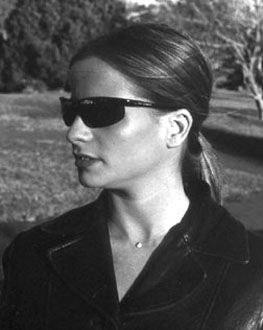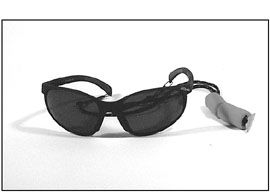For most people, sunglasses are all about style. For sailors, however, they play a critical safety role in personal health as well as the fight against fatigue.

Sunglasses—and the highly competitive market that produces them—have changed since our last look at them (August 15, 1998). Generally, the glasses are lighter, thanks to nylon composite frames, sleeker (the wraparound effect serves a functional as well as aesthetic purpose) and offer more features, such as polarization and anti-reflective coatings.
For this review, we concentrated on mid-range glasses that are both stylish and highly functional. Prices ranged from about $70 to $200, with an average price of $125. Sure, you can take a pair of $10 glasses off a rack at the drugstore and still get decent ultraviolet-ray protection, but you won’t get the frame quality, durability and warranty protection that this class offers. And you may not be getting the maximum UV blocking that’s necessary on the water.
Nikon, which produced some of our favorite glasses last time, is out of the eyewear business. The same goes for Sun Cloud, which offered some reasonably priced shades of good quality. Revo is now part of the Luxxotica Group, which has cut the price on its high-end, status glasses—Ray Ban and Arnette. It remains to be seen whether the quality changes as well. Luxxotica declined to speak with us or provide any samples for this project.
Safety Concerns
For anyone who spends time on the water, sunglasses are a necessity. Besides improving your vision, they provide important protection against eye lens damage from ultraviolet rays. Among the ailments attributed to UV are cataracts, macular degeneration or snow blindness, and cancer of the eye and eyelid. Prolonged exposure can also create painful “sunburn” on the cornea. In addition, constant exposure to wind, dust and snow can lead to a condition known as pterygium, a growth of cells between the eyelids and the cornea that requires surgical correction.
Although it is not always clear from labeling, there are voluntary standards from the American National Standards Institute (ANSI) that govern levels of UV protection. Three levels exist. Cosmetic lenses must absorb 70% of UVB (shorter rays) but only 20% of UVA (longer rays)—or equal to the reduction in visible light; we’d judge this insufficient for boating purposes. General-purpose lenses must absorb at least 95% of UVB and 60% of UVA; that’s OK for general purposes but not in highly reflective environments such as the water. Special-purpose lenses provide the best protection, blocking 99 % of UVB and 60% of UVA. When in doubt, it’s reasonable to expect that the darkest lenses will keep out the most visible light and UV rays.
Manufacturers also label their glasses by the amount of light transmission allowed. Ideally, 70% of available light should be filtered out. Ultrasol, for example, states that its brown lenses filter all but 15% of transmittable light, its gray-green lenses 18%.
While the quality of the lens is paramount, design and fit also are important. Eyes need protection from overhead light as well as light reflected from the water, your boat and other boats. A snug, form-fitting design best blocks this incidental light. A curved, wraparound design blocks rays without interfering with side vision—a problem we found with several models last time. Distance between lens and eye should be minimal, but not so close that your eyelashes brush the lenses. We suggest that prospective buyers carefully try on many makes and models to find the right fit.
Below are additional considerations.
Glass vs. Plastic
Many wearers favor plastic lenses because they are lighter and cheaper as well as more durable than their glass counterparts. Because they resist shattering, they are safer than glass in many applications, including active sports. Their shatter resistance also permits thinner lenses. Glass lenses, on the other hand, offer better visual accuracy and are less susceptible to scratching, although some plastic lenses have scratch-resistant coatings. Glass is also used for photochromatic lenses, which darken or lighten in response to changes in brightness.
Among the poly lenses, polycarbonate lenses offer great durability but are most prone to scratching—a real drawback at current retail prices. CR-39, another plastic, is harder, less scratchable and lighter than polycarbonate. Several of the brands we looked at, including Oakley and Hobie, offer easily replaced lenses for some models—a real plus for switching tints as light conditions change, and for replacing a scratched lens.
Lens Color
Gray-green lenses (our personal preference) don’t distort natural colors much and, in conjunction with polarization, seem to enhance one’s ability to “see” the surface of the water.
Many people like the ability of amber- or rose-tinted lenses to increase clarity and contrast—especially useful on hazy days—and generally make the world appear brighter. Some experts also believe that the ability of amber and brown lenses to filter out shortwave “blue light” rays helps protect against retinal damage (i.e., macular degeneration) for those who incur lots of exposure to sunlight. On the other hand, any dark lens that reduces admittance of visible light also cuts down on blue light. The biggest drawback to amber and rosy lenses is a noticeable distortion of colors, which bothers some people but others not at all.
Polarization
Polarization will cost you a bit more, but its function—reducing glare—is well worth it. Boaters report—and we’ve noticed ourselves—that polarization seems to allow you to see deeper beneath the surface of the water. All of the glasses we looked at had polarized lenses.
Anti-Reflective/Flash Coatings
Anti-Reflective Coating (ARC) reduces light reflection from both the back and front of lenses, so-called “bounce-back light” that’s not only distracting but also fatiguing. A recent study by the St. Louis School of Optometry (state troopers were used as their guinea pigs) determined that ARC improved vision by about 8% while also reducing glare.

Mirrored or flash-coated lenses are designed to reduce glare from above and below—important considerations on the water. For some, there’s also an undeniable fashion effect (our Costa Del Mar Fathoms have fluorescent green flashing on the front but are amber-tinted when you look through the lens). Early mirror coatings were criticized for their scratchability, but newer technology has solved this problem. Maui Jim, for example, thermally applies its “bi-gradient” mirror coating, topped with a waterproof coating. The silver dioxide material it uses also does away with opaque “state trooper” mirror effect and leaves a natural-looking lens.
How We Tested
First, we simply wore the glasses during our daily outdoor activities to see how they felt. Comfort is highly subjective, though, and depends to a great degree on the size and shape of an individual’s head. If glasses were too small or tight for us, we let others try them also.
In terms of performance, we tried viewing a digital display (our handheld Garmin GPS) with each pair. While optic quality seems to make a difference, so does the darkness of a lens, i.e., the amount of light it blocks. By that standard, our regulation gray-lens Maui Jim Commanders weren’tthe greatest (other Maui Jims were fine). However, we’ve worn them on many a boat test without any vision problems.
We spent a lot of time looking at the cove outside our door, trying on the different models and noting any improvement or lack thereof in our vision. And we scrutinized a geometric pattern on the floor to check for distortion (more a problem with plastic lenses).
Here’s what we found.
$100 And Under
We looked at four different models retailing for $100 or less, including two Bollés, one Hobie and one pair of Action Optic Breakwaters. While price may not always reflect value or quality, it did in this case. These were our least favorite.
Action Optics is affiliated with Smith, which commands considerable respect among younger users, primarily for style but also for good optics and customer service. Action Optics—oriented more toward sports and outdoor use—are reasonably priced (the Breakwater costs $69.95). Action Optics’ polarization gives them an edge over the non-polarized Smith glasses. The Breakwaters have a Grilamid nylon frame and eight-base lens with scratch-resistant coating; they also have the heftiest hinges in this group.
Our Hobie Slivers ($100) were the only model in this group with CR-39 lenses, also eight-base, instead of polycarbonate. Bollés don’t carry quite the cachet they once did and, in fact, come in fairly basic nylon frames, a bit more stylish than previous models. Bollés’ Piraja, one of the Super Snakes series, boasts a new “absorber” hinge, though we wouldn’t push it too far. Both the Piraja and the silver-framed Natrix have padded ear ends, and the Natrix has Sandstone-tinted lenses that have a gold flash coating as well as ARC coating.
$100-$149
Serengeti, the Italian eyeglass company, now offers a line of water sports-oriented glasses, labeled H2Optix, that aren’t all that expensive. These reasonably stylish glasses wrap nicely and offer both polarization and ARC. They also come with a floating neck strap—good idea—that positively locks through tiny holes at the ends of the frame. That’s an improvement over the slide-over/tie-a-knot straps that tend to come loose. The H2Optix have polycarbonate lenses, fairly workaday lightweight frames and are quite comfortable. At $104 each for the three models we tried (Captiva, Laguna, St. Croix), we’d call them a Best Buy in this higher-priced category.

Action Optics Riptides ($133) have polarized (but without ARC) glass lenses in an acetate frame. Our version had a tortoise shell frame that fit us (a bit too) snugly and copper-tinted lenses that were very warm. This model is photochromatic, which may be of some help in fading light conditions. These are sturdy, if plain vanilla, glasses with a solid hinge.
We’d place both pairs of the Costa Del Mars—the Tempest and the Fathom—into this middle category. The Tempest ($109, add $10 for polarization) has an eight-layered CR-39 lens with ARC and a water-shedding coating—another plus for those who take a lot of spray. The nylon composite frames aren’t especially stylish but were comfortable enough; the rubberized frame tips help hold the glasses on without the need for a neck strap. The more-stylish Costa Del Mar Fathoms had an iridescent green mirror finish over an amber-tinted glass lens. All Costa Del Mar sunglasses, except for prescription lenses, come with a lifetime warranty (most are 1-year)—but, alas, this doesn’t cover lost glasses.
It’s hard to beat Oakley when it comes to style (at least in sleek, modernistic terms), and one of our models, a Frogskin, makes you pay for it ($145). We found this mid-size model a little tight but a good wrap alternative for women (with long eyelashes), especially with its deeper lens sockets.
There were two sports wraps in this price range: the Bollé Parole ($119.95) and the Maui Jim Sunset. The radically styled Paroles would look more at home on a cyclist or jet skier. A neat feature: They come with interchangeable poly lenses—vermilion, gray, yellow and clear—for different conditions. Polarization was not available on 2000 models but will be this year. We found the Paroles’ rubberized “Thermo-Grip” nosepiece reasonably comfortable. Downside: The unrimmed bottoms let in reflected light from below.
Maui Jim’s MJ Sports Sunsets aren’t as radical and don’t come with interchangeable lenses. However, they are very comfortable, allow in less reflected light and the poly lenses with ARC and polarization provide distinctly sharper optics, in our opinion. We’d definitely pay the extra $10 (suggested retail $129) for the MJs.
$150 And Up
Ultrasol, a micro-player in the sunglasses industry, produces well-made glasses that have developed a cult following, especially on the West Coast. Our Ultrasol Tremors ($150) were very solid, with heavy-duty spring hinges. Consequently, they weigh a bit more—just under 2 oz. with three-layer lenses (chemically hardened after polishing). Company owner Carlos Anorga sent along a testimonial from the Instrument Development Group at UC’s Scripps Institution of Oceanography saying that Ultrasols finished at the top in their five-way sunglasses test. The lenses provide lots of contrast and a bright view of the world, with only minimal distortion. Ours were tropical brown, great for blocking blue light, according to Anorga.
We also tried a pair of Hobie Montegos ($160). The rubberized frame helps keep them on your head. It may be us, but we’ve always found Hobies a little uncomfortable (these were tight), and we also were bothered by some bounce-back reflection. The three-piece lens, in this case, consists of two pieces of ophthalmic-grade glass around a polarizing film. Hobies are undoubtedly rugged, and the use of either glass or CR-39 makes for more durability and less scratching. Still, we believe the technology is there to incorporate both anti-glare and anti-reflective coatings without undue susceptibility to scratching.
Oakley has created its own universe, one where lenses are Plutonium® (rather than polycarbonate) and don’t just have anti-glare but coatings of iridium. Our Frogskin Twenty model ($155) also had an Unobtanium (rubberized) nose piece and ear socks for good gripping, as well as XYZ Optics®. Oakley reps actually bring a laser shooter with them to vendors to demonstrate the superior light transmission of their lenses (although we’ve heard that Arnettes do well, too). A company spokeswoman says the lack of distortion enables you to see through Oakley lenses without a lot of refocusing, which can be fatiguing. Whatever. In practice, we foundOakleys to be easy on the eyes.
Our other Oakleys in this category was a pair of the fairly radical C Wires ($195), with a silver-metal frame of C-5 alloy fired in a “power hungry furnace,” according to the catalog, and gold Iridium Plutonite lenses. They’re fairly small, light , and aimed at women, the spokeswoman said. Like the Ultrasol, the C Wire has a spring hinge that maintains proper fit.
A few years ago, a vendor told us Maui Jims owed their popularity to their comfort. That alone says something. But Maui Jim lenses also are among the most sophisticated available, offering what the company calls PolarizedPlus. A standard MJ lens consists of two pieces of hand-ground glass with a thin polarizing film in between; on the front of the sandwich there’s an additional anti-glare coating of silver dioxide; on the back is an AR coating of magnesium hexaflouride. Both sides are finished with a waterproof coating that’s thermally bonded to the lens. MJ calls its mirror coating bi-gradient, which means that the shading is at the top and bottom of the lens and doesn’t interfere with straight-ahead vision.
All this gives an MJ lens a kind of mottled look, but the view through the lenses is optically crisp. We have to disclose a prejudice here: After trying on a pair of MJ Commanders ($195) more than a year ago, we haven’t gone back to our Ray Ban aviator glasses. We’ve used the Commanders to fight off glare from snow, in fog and haze, and under the bright Florida sun during boat tests. They are comfortable to wear for long periods of time, do the job, and don’t interfere with vision, including reading instruments and LED readouts. And unlike our old favorites, the Ray Bans, the wire frames haven’t bent out of shape. We also like the stylish but conservative look compared to some of the super-sleek metallic frames. One possible drawback: A fair amount of room between eye and lens lets in some side reflection. That’s less a problem with the MJ Typhoon ($169), which has a black nylon composite frame and (in this case) gray lenses and a closer fit.
Conclusion
Backed by our experience with a number of brands, and this most recent comparison, we’d pick Maui Jim—with all the protection features, plus comfort—as our favorite. A final telling point: In an informal survey of vendors, Maui Jim was far and away rated tops in customer service, with a very quick turnaround on repairs or warranty claims—days instead of weeks. That said, we found an awful lot of well-made, serviceable sunglasses, including Oakley and Costa Del Mar.
And as a mid-price alternative, we wouldn’t mind keeping a spare pair of Serengetis on board.
Of the four models under $100, we liked the Action Optics Breakwater for its basic comfort and sturdier hinge, and the Bollé Natrix (lightest of all our glasses at just 5/8 oz.) for its clear vision and comfort. Still, we’d be inclined to look in a higher-priced category.
Also With This Article
Click here to view “Fitovers For Prescription Glasses.”
Click here to view Value Guide: Sunglasses.
Contacts- Bollé, Bushnell Optics, 9200 Cody, Overland, KS 66214, 800/222-6553, www.bolle.com. Costa Del Mar, 123 N. Orchard, Ormond Beach, FL 32174, 800/447-3700, www.costadelmar.com. Hobie, 5866 S. 194th St., Kent, WA 98032, 800/554-4335, www.hobie.com. Maui Jim, 1200 W. Bird Blvd., Peoria, IL 61615; 888/628-4546, www.mauijim.com/. Oakley, One Icon, Foothill Ranch, CA 92610, 800/733-6255, www.oakley.com. Serengeti, 8125 25th Ct., East Sarasota, FL 34243, 941/359-3599, www.serengeti-eyewear.com. Smith, Action Optics, 280 Northwood Way, Ketchum, ID 83340, 800/654-6428, www.actionoptics.com.
































